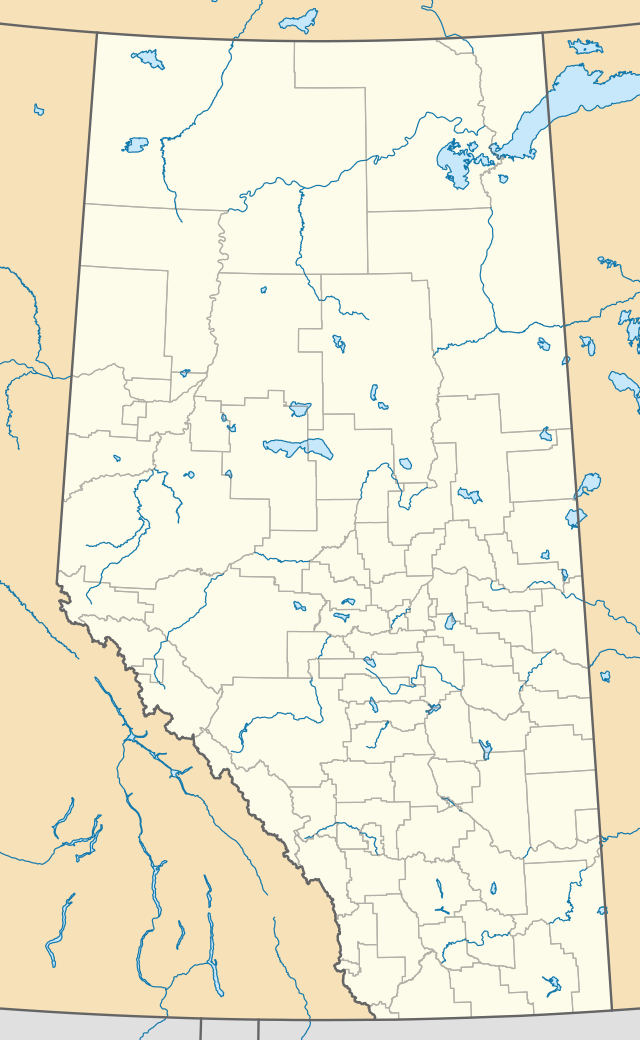Big Stone, Alberta
Big Stone is an unincorporated community in southern Alberta in Special Area No. 3, located 28 km (17 mi) south of Highway 9, 142 km (88 mi) northwest of Medicine Hat.

Big Stone
Location of Big Stone Alberta
The community takes its name from nearby Bigstone Creek.[1]
Climate
Big Stone experiences a semi-arid climate (Köppen climate classification BSk) with long, cold, dry winters and short, warm summers. Precipitation is low, with an annual average of 337.4 mm (13.28 in), and is concentrated in the warmer months.
| Climate data for Big Stone | |||||||||||||
|---|---|---|---|---|---|---|---|---|---|---|---|---|---|
| Month | Jan | Feb | Mar | Apr | May | Jun | Jul | Aug | Sep | Oct | Nov | Dec | Year |
| Record high °C (°F) | 12.0 (53.6) |
14.5 (58.1) |
21.5 (70.7) |
29.5 (85.1) |
35.0 (95.0) |
37.0 (98.6) |
36.5 (97.7) |
38.0 (100.4) |
35.0 (95.0) |
28.0 (82.4) |
21.5 (70.7) |
14.5 (58.1) |
38.0 (100.4) |
| Average high °C (°F) | −7.6 (18.3) |
−4.4 (24.1) |
2.9 (37.2) |
13.0 (55.4) |
18.6 (65.5) |
22.6 (72.7) |
25.3 (77.5) |
25.2 (77.4) |
19.0 (66.2) |
11.8 (53.2) |
0.0 (32.0) |
−5.8 (21.6) |
10.1 (50.2) |
| Daily mean °C (°F) | −12.7 (9.1) |
−9.5 (14.9) |
−2.5 (27.5) |
6.1 (43.0) |
11.6 (52.9) |
15.8 (60.4) |
18.2 (64.8) |
17.9 (64.2) |
12.0 (53.6) |
5.1 (41.2) |
−5.0 (23.0) |
−10.9 (12.4) |
3.8 (38.8) |
| Average low °C (°F) | −17.8 (0.0) |
−14.5 (5.9) |
−7.8 (18.0) |
−0.9 (30.4) |
4.6 (40.3) |
9.0 (48.2) |
10.9 (51.6) |
10.6 (51.1) |
4.8 (40.6) |
−1.7 (28.9) |
−10.0 (14.0) |
−16.0 (3.2) |
−2.4 (27.7) |
| Record low °C (°F) | −41.5 (−42.7) |
−40.0 (−40.0) |
−30.5 (−22.9) |
−14.0 (6.8) |
−6.0 (21.2) |
−1.5 (29.3) |
2.5 (36.5) |
−1.0 (30.2) |
−8.0 (17.6) |
−28.5 (−19.3) |
−37.5 (−35.5) |
−43.0 (−45.4) |
−43.0 (−45.4) |
| Average precipitation mm (inches) | 14.2 (0.56) |
8.6 (0.34) |
13.5 (0.53) |
19.0 (0.75) |
44.6 (1.76) |
73.0 (2.87) |
54.9 (2.16) |
35.1 (1.38) |
32.7 (1.29) |
12.3 (0.48) |
14.8 (0.58) |
14.8 (0.58) |
337.4 (13.28) |
| Average rainfall mm (inches) | 0.0 (0.0) |
0.2 (0.01) |
1.4 (0.06) |
12.4 (0.49) |
43.4 (1.71) |
73.0 (2.87) |
54.9 (2.16) |
35.1 (1.38) |
31.8 (1.25) |
7.4 (0.29) |
1.3 (0.05) |
0.9 (0.04) |
261.7 (10.30) |
| Average snowfall cm (inches) | 14.1 (5.6) |
8.4 (3.3) |
12.1 (4.8) |
6.6 (2.6) |
1.3 (0.5) |
0.0 (0.0) |
0.0 (0.0) |
0.0 (0.0) |
0.9 (0.4) |
5.0 (2.0) |
13.5 (5.3) |
13.8 (5.4) |
75.7 (29.8) |
| Average precipitation days (≥ 0.2 mm) | 5.7 | 4.3 | 5.5 | 5.3 | 8.9 | 11.9 | 10.3 | 8.6 | 7.5 | 5.1 | 5.8 | 6.6 | 85.3 |
| Average rainy days (≥ 0.2 mm) | 0.1 | 0.3 | 0.8 | 3.9 | 8.8 | 11.9 | 10.3 | 8.6 | 7.2 | 3.8 | 1.2 | 0.3 | 57.2 |
| Average snowy days (≥ 0.2 cm) | 5.5 | 4.0 | 4.9 | 1.9 | 0.4 | 0.0 | 0.0 | 0.0 | 0.4 | 1.7 | 4.9 | 6.4 | 30.1 |
| Source: Environment Canada[2] | |||||||||||||
References
- Place-names of Alberta. Ottawa: Geographic Board of Canada. 1928. p. 19.
- "Canadian Climate Normals 1971–2000". Environment Canada. Retrieved 23 January 2012.
This article is issued from Wikipedia. The text is licensed under Creative Commons - Attribution - Sharealike. Additional terms may apply for the media files.